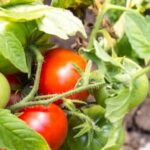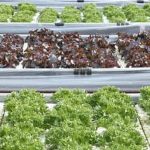Food grade diatomaceous earth can be used in vegetable gardens as a natural pest control method and soil amendment. Diatomaceous earth is a powdery substance made from the fossilized remains of marine phytoplankton, known as diatoms.
In gardening, food grade diatomaceous earth is popular for its ability to control pests and promote plant health without the use of harmful chemicals. This article will explore the benefits, risks, and best practices of using food grade diatomaceous earth in vegetable gardens to help you make an informed decision for your garden.
Diatomaceous earth has been used in various applications, including agriculture and gardening, for its natural insecticidal properties. In vegetable gardens, it can effectively control pests while being safe for plants, soil, and beneficial insects.
Additionally, diatomaceous earth can improve soil health by retaining moisture and nutrients in the root zone of plants. As we delve into the details of using food grade diatomaceous earth in vegetable gardens, you will discover how it can be a valuable addition to your gardening practices.
In this section, we will provide an overview of what food grade diatomaceous earth is and how it is utilized in gardening. Subsequently, we will explore its benefits when used in vegetable gardens such as pest control advantages, plant health benefits, and environmental impact considerations.
Furthermore, we will discuss practical tips on how to apply food grade diatomaceous earth in vegetable gardens and important safety precautions to keep in mind. Stay tuned for insightful information on maximizing the potential of food grade diatomaceous earth in your garden while minimizing any associated risks.
Benefits of Using Food Grade Diatomaceous Earth in Vegetable Gardens
Food Grade Diatomaceous Earth (DE) is a natural pest control method that can be used in vegetable gardens. DE is composed of the fossilized remains of diatoms, a type of hard-shelled algae. When ground into a fine powder, it becomes an effective pesticide. It works by absorbing lipids from the waxy outer layer of insects’ exoskeletons, causing them to dehydrate and die.
When used in vegetable gardens, food grade diatomaceous earth offers several benefits. Firstly, it provides effective pest control without the use of harmful chemicals. This means that you can protect your crops from pests without introducing potentially toxic substances into your garden or food supply. Additionally, because it targets a wide range of pests including ants, aphids, and beetles, it’s a versatile solution for many different garden problems.
Moreover, not only does food grade diatomaceous earth help control pests in vegetable gardens, but it also promotes overall plant health. Its absorbent properties make it an excellent soil amendment as well. DE can help retain moisture in sandy soils and improve drainage in clay soils. This means that your plants are better equipped to handle environmental stressors like drought while getting the nutrients they need to thrive.
| Benefits | Considerations |
|---|---|
| Effective pest control without harmful chemicals | Watch out for effects on beneficial insects |
| Versatile solution for many different garden problems | Residue concerns and safety precautions for handling |
| Promotes overall plant health by improving soil quality | Potential skin and respiratory irritations upon direct contact |
How to Use Food Grade Diatomaceous Earth in Vegetable Gardens
Food grade diatomaceous earth is a versatile and effective product that can be used in vegetable gardens for pest control and plant health. When using food grade diatomaceous earth in your vegetable garden, it is important to follow proper application methods and safety precautions to ensure its efficacy and minimize any potential risks.
When applying food grade diatomaceous earth in vegetable gardens, there are several methods that can be used. One common method is to sprinkle a thin layer of the diatomaceous earth around the base of plants or directly onto the leaves. This creates a barrier that will help control pests on the plants. Another method is to mix the food grade diatomaceous earth with water to create a spray solution, which can be applied to the plants as needed.
It is important to take safety precautions when using food grade diatomaceous earth in vegetable gardens. Since it is a fine powder, it can cause irritation if inhaled or if it comes into contact with the skin or eyes.
Therefore, it is recommended to wear gloves, goggles, and a mask when handling and applying the product. Additionally, it’s best to apply the diatomaceous earth on a calm day to prevent it from blowing away and avoid applying it directly onto flowers where pollinators may land.
| Application Methods | Safety Precautions |
|---|---|
| Sprinkle around base of plants or on leaves | Wear gloves, goggles, mask on calm day |
| Mix with water for spray solution | Avoid direct contact with skin or eyes |
Best Practices for Incorporating Food Grade Diatomaceous Earth Into Vegetable Gardens
When it comes to incorporating food grade diatomaceous earth into your vegetable garden, there are some best practices that can help ensure you get the most out of this natural pest control method. One of the most important things to consider is the timing and frequency of application.
It’s best to apply the diatomaceous earth when the soil is dry, as it will be more effective at controlling pests. As for frequency, reapplying after rain or heavy watering may be necessary.
In addition to timing and frequency, it’s also important to consider the specific needs of different types of vegetables. Some plants may be more sensitive to diatomaceous earth than others, so it’s crucial to research and understand the individual requirements of the vegetables in your garden. For example, leafy greens like lettuce and spinach may need a different approach compared to root vegetables like carrots and potatoes.
Another important consideration when using food grade diatomaceous earth in your vegetable garden is applying it safely. This means wearing protective gear such as gloves and a mask when handling the product. It’s also essential to keep children and pets away from treated areas until the diatomaceous earth has settled into the soil. By following these best practices, you can make sure that food grade diatomaceous earth is used effectively and responsibly in your vegetable garden.
Types of Pests Controlled by Food Grade Diatomaceous Earth
Food grade diatomaceous earth (DE) is an effective and natural pest control option for vegetable gardens. When used properly, it can help to protect your plants from a variety of common garden pests without the use of harmful chemicals. Here are some of the types of pests that can be controlled with food grade diatomaceous earth:
- Aphids: These small insects can wreak havoc on vegetable plants by sucking sap from the leaves and stems, causing wilting and yellowing.
- Slugs and snails: These slimy pests can quickly destroy young seedlings and munch on leaves, making them a nuisance in the garden.
- Ants: While not directly harmful to plants, ants can protect and transport aphids, scale insects, and other pests, leading to damage on your vegetable crops.
Specific examples of successful pest control using food grade diatomaceous earth include:
- Reduced aphid infestations on pea plants after sprinkling DE around the base of the plants
- Decreased slug damage on lettuce by creating a barrier of DE around the perimeter of the garden bed
- Controlled ant populations by applying DE along their trails and entry points into the garden
By using food grade diatomaceous earth in your vegetable garden, you can effectively combat these common pests in a safe and environmentally friendly manner. However, it’s important to consider potential risks and drawbacks as well as alternative pest control methods when implementing this natural solution.
Potential Risks and Drawbacks of Using Food Grade Diatomaceous Earth
Food grade diatomaceous earth is a natural pest control option that is commonly used in vegetable gardens. However, despite its benefits, there are potential risks and drawbacks associated with its use. It is important for gardeners to be aware of these considerations in order to make an informed decision about incorporating food grade diatomaceous earth into their gardening practices.
Some potential risks and drawbacks of using food grade diatomaceous earth in vegetable gardens include its effects on beneficial insects, concerns about residue, and the potential for skin and respiratory irritations.
- Effects on beneficial insects: While food grade diatomaceous earth can effectively control pests such as slugs, beetles, and other harmful insects, it may also have an impact on beneficial insects such as bees and ladybugs. When using diatomaceous earth in a vegetable garden, it is important to carefully consider its potential effects on the overall ecosystem, including beneficial insect populations.
- Residue concerns: Another drawback of using food grade diatomaceous earth is the concern about residue left on vegetables. While it is generally considered safe for consumption when used properly, there is still a possibility of residue remaining on the plants. This is an important consideration for organic gardeners or those who prioritize chemical-free produce.
- Skin and respiratory irritations: When applying food grade diatomaceous earth in vegetable gardens, it is essential to take appropriate safety precautions. This substance can pose a risk of skin and respiratory irritation if proper protective gear and handling procedures are not followed. Gardeners should be mindful of potential health concerns related to the use of diatomaceous earth.
Overall, while food grade diatomaceous earth offers effective pest control for vegetable gardens, it is crucial to weigh these potential risks and drawbacks against its benefits. By considering these factors and taking necessary precautions, gardeners can make informed decisions about whether or not to incorporate this natural pest control method into their gardening practices.
Alternative Pest Control Methods for Vegetable Gardens
Organic Options
When it comes to pest control in vegetable gardens, many gardeners prefer to use organic methods. In addition to food grade diatomaceous earth, there are a variety of other organic options available. One popular choice is neem oil, which is derived from the seeds of the neem tree and can be used to combat a wide range of pests.
Another option is insecticidal soap, which effectively controls soft-bodied insects like aphids, mites, and mealybugs. Additionally, introducing beneficial insects such as ladybugs and predatory wasps can help keep pest populations in check.
Integrated Pest Management Strategies
Integrated pest management (IPM) is a comprehensive approach to pest control that emphasizes ecological principles and minimizes reliance on chemical pesticides. An important aspect of IPM is maintaining a healthy garden ecosystem by promoting biodiversity and using cultural practices like crop rotation and companion planting to deter pests. Monitoring the garden regularly for signs of pests or damage can also help identify issues early on, allowing for targeted interventions when necessary.
By incorporating these alternative pest control methods into your vegetable garden management plan, you can reduce the need for chemical pesticides while still effectively managing pest populations. This approach not only benefits the environment but also contributes to the overall health and productivity of your vegetable plants.
Final Thoughts
While food grade diatomaceous earth is a valuable tool for controlling pests in vegetable gardens, it’s important to consider alternative pest control methods as well. By combining different strategies and techniques, you can create a balanced approach to pest management that promotes a thriving garden ecosystem while minimizing harm to beneficial organisms and the environment as a whole.
Tips for Selecting and Using Food Grade Diatomaceous Earth
Food grade diatomaceous earth is a natural insecticide that is safe to use in vegetable gardens and around the home. When selecting and using food grade diatomaceous earth, it’s important to consider several factors to ensure its effectiveness and safety.
What to Look for When Purchasing Diatomaceous Earth
When purchasing food grade diatomaceous earth for use in vegetable gardens, it’s crucial to ensure that the product is labeled as “food grade.” This designation indicates that the diatomaceous earth has been processed specifically for use in food production and that it does not contain any harmful additives or chemicals. It’s also recommended to look for products that are registered with the Environmental Protection Agency (EPA) to ensure their safety and effectiveness.
Proper Storage and Handling Techniques
Once you have selected your food grade diatomaceous earth, it’s important to store it properly to maintain its efficacy. Diatomaceous earth should be kept in a dry, cool area away from moisture and direct sunlight. Additionally, when applying diatomaceous earth in the garden, it’s essential to wear protective gear such as goggles, gloves, and a mask to avoid inhaling the fine particles.
Application Methods
Food grade diatomaceous earth can be applied both as a dust or mixed with water and sprayed onto plants. When using as a dust, apply a thin layer directly onto plant leaves and surrounding soil.
As a spray, mix the diatomaceous earth with water according to package instructions and apply using a pump sprayer or watering can. Regardless of the application method, it’s essential to reapply after rainfall or irrigation as water will wash away the protective barrier created by the diatomaceous earth.
These tips for selecting and using food grade diatomaceous earth will help ensure successful pest control in your vegetable garden while minimizing environmental impact and health risks.
Conclusion
In conclusion, food grade diatomaceous earth can be a highly effective and beneficial addition to any vegetable garden. Its natural pest control properties, plant health benefits, and minimal environmental impact make it an attractive choice for many gardeners. By using this organic product, gardeners can effectively manage pests while promoting the health of their beloved vegetables without the use of harmful chemicals.
When incorporating food grade diatomaceous earth into vegetable gardens, it is important to follow recommended application methods and safety precautions. This includes ensuring that the product is used properly and in a manner that minimizes any potential risks or drawbacks. By adhering to best practices and considering the specific needs of different types of vegetables, gardeners can maximize the benefits of food grade diatomaceous earth while minimizing any negative impacts.
While there are potential risks and drawbacks associated with using food grade diatomaceous earth in vegetable gardens, such as its effects on beneficial insects and residue concerns, these can be managed through careful application and adherence to best practices. Additionally, there are alternative organic pest control methods available for those who may have concerns about using diatomaceous earth in their gardens.
Overall, when used responsibly and in accordance with best practices, food grade diatomaceous earth can be a valuable tool for maintaining healthy and thriving vegetable gardens.
Frequently Asked Questions
Is Diatomaceous Earth Safe for Vegetable Gardens?
Diatomaceous Earth is generally considered safe for use in vegetable gardens. It can help control pests like slugs, beetles, and other insects without harming the plants or affecting the soil.
Can I Use Diatomaceous Earth on My Tomatoes?
Yes, you can definitely use Diatomaceous Earth on your tomatoes. When used properly, it can help control pests like aphids, caterpillars, and other insects that commonly affect tomato plants.
What Is the Difference Between Food Grade and Garden Grade Diatomaceous Earth?
The main difference between food grade and garden grade Diatomaceous Earth is their intended use. Food grade DE is safe for consumption by humans and animals, while garden grade DE is specifically designed for pest control in gardens and agricultural settings. Both types are made from the same natural substance but have different applications.

If you’re looking to get into vegetable gardening, or are just looking for some tips on how to make your current garden better, then you’ve come to the right place! My name is Ethel and I have been gardening for years. In this blog, I’m going to share with you some of my best tips on how to create a successful vegetable garden.





